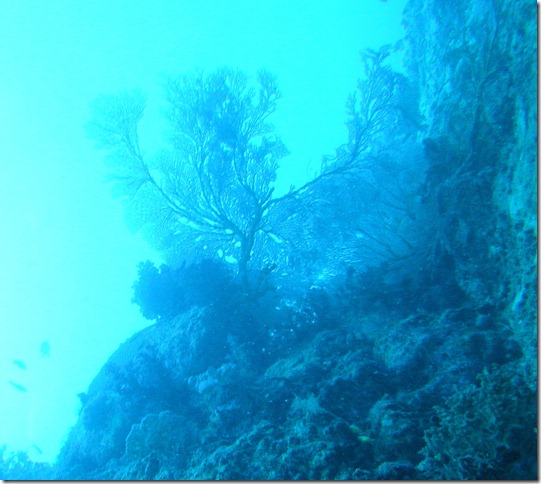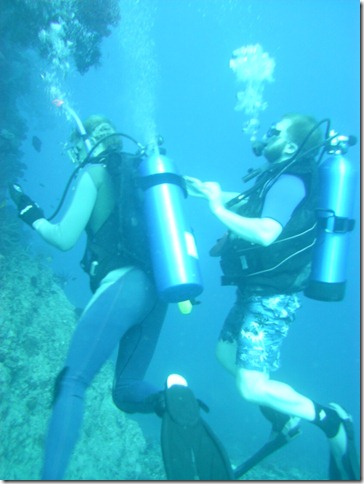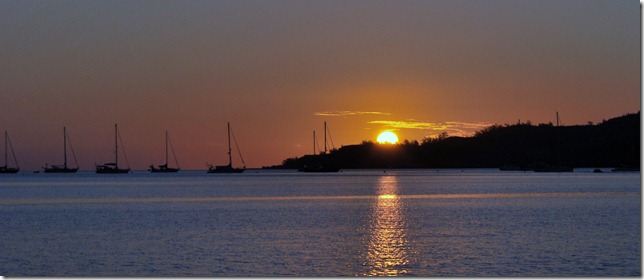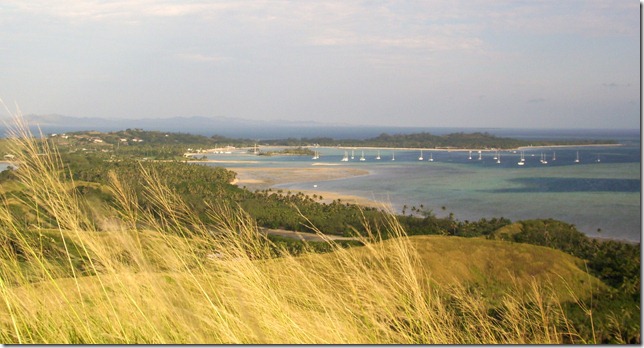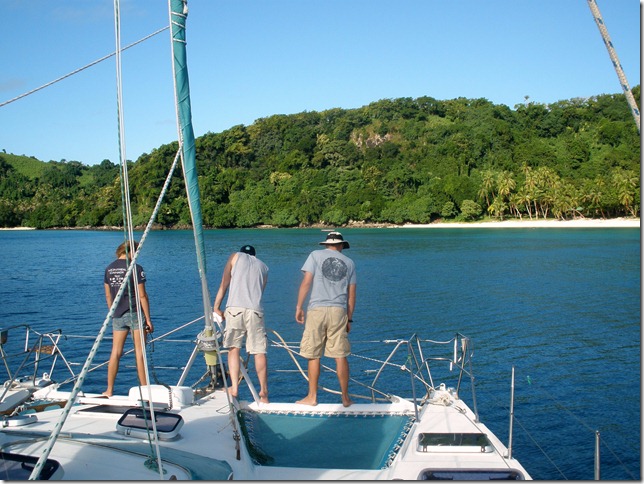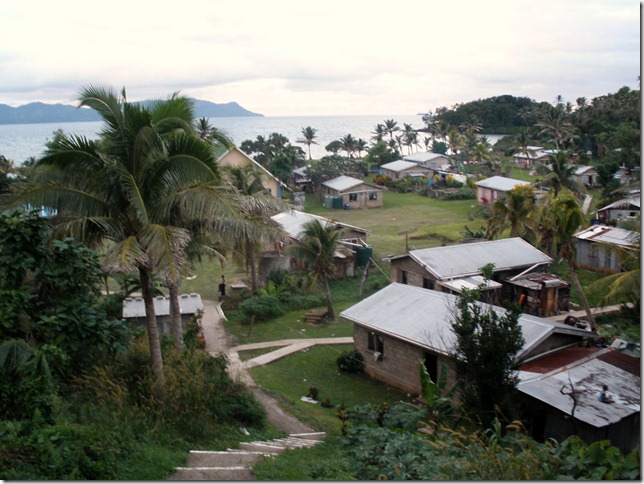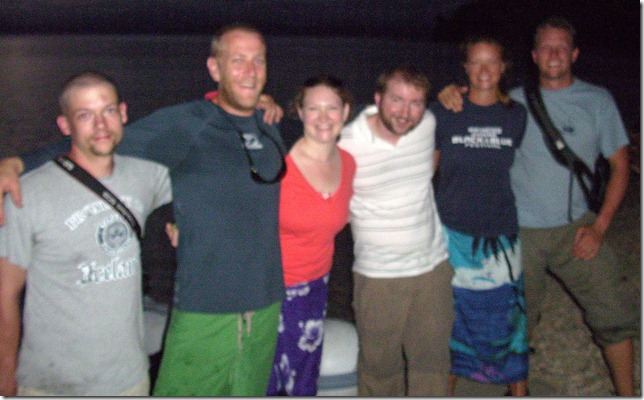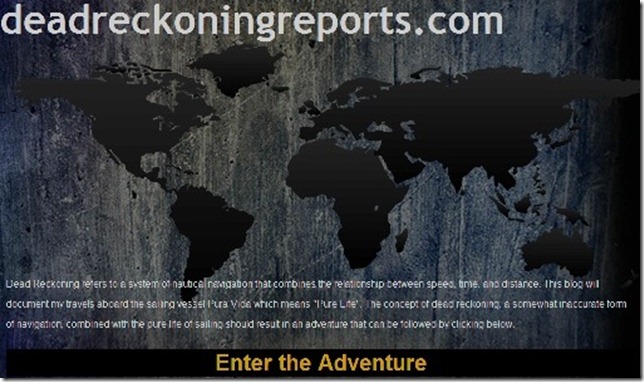With a young crew that includes single guys, nightlife is always appreciated and there’s not much of it on most islands. One notorious exception is the Beachcomber Resort on tiny Beachcomber Island. It’s apparently earned a bit of a reputation in Fiji and in the Pacific in general, so we decided to make a stop on our journey through the islands. We left Musket Cove, enjoyed a great dive just outside the entrance to the channel into Musket Cove, and then headed to Beachcomber. We arrived, contacted the island, and then tied up to a mooring as they had recommended. The mooring had a float so big that it looked like it was designed for a supertanker mooring. We finally managed to find a loop of line that we could slip one of our lines through and enjoyed a swim, a cool breeze, and the setting sun while we watched a couple of catamaran ferries stop near the island to pick up and drop off backpackers. The island is very small (a walk around it takes about 5 minutes) and the nearby water is too shallow for the large cats to land, so smaller launches ferry passengers between the island and the waiting boats.
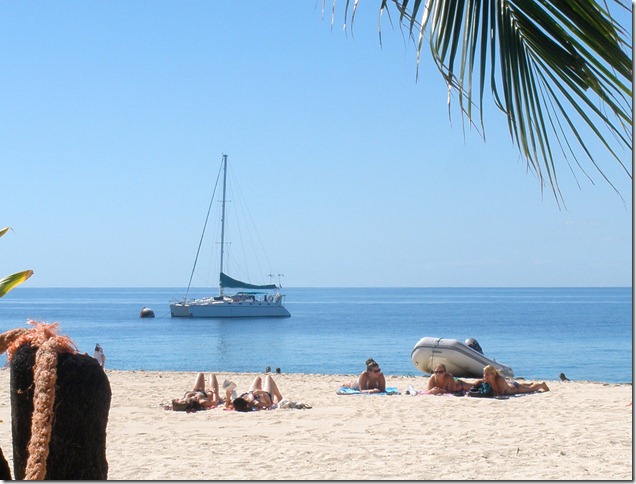 Not a bad place to spend a day
Not a bad place to spend a day
The place didn’t quite live up to its reputation, but we did have a good time, made some friends, and survived another late night. Colin kept his camera out all night, so the next morning we were able to confirm that Colin had stooped from photojournalist to party photographer, Ash had managed to dance with nearly every woman present, and it was a rare moment when Lauren wasn’t on the dance floor.
The next day we went in to the dive shop to get a couple of our tanks repaired. We had one tank leaking after our first dive and fixed it at the Musket Cove dive shop by replacing the neck O-ring. Two other tanks that were new when we left the US showed the same problem on our second dive and we were able to fix them at the Beachcomber dive shop. After chatting with the guys at both shops and watching/helping with the work I was able to get all three fixed for essentially the cost of the tank fills we needed to test the fixes and get three spare O-rings as well.
The next day, everyone enjoyed a good snorkel in the clear water while I filled dive tanks. We’d seen numerous dive boats on moorings out near the reef and by the early afternoon we were headed out to have our first dive in Fiji, but not before I got a chance to refresh my free diving skills. The anchor was stuck under a coral head, and after several attempts to dislodge it failed, I ended up free diving the 25-30 ft to pull it loose by hand. I was pretty surprised that I was able to make it down on the first dive of the year, but it actually wasn’t too bad. The lagoon is large enough that there was a pretty good swell to deal with when we finally found a mooring atop a large, natural underwater tower and picked it up.
James joined Lauren and I for the dive, and between needing a little more weight for James and the rough conditions on the surface, it took us 5-10 tiring minutes to finally get in position and drop down. We hadn’t been diving since Tonga, and the first sensation was just how incredibly peaceful it is underwater. We’re fairly comfortable diving now, and it’s so nice to be able to relax and enjoy things. I don’t think we were in the best spot for soft coral, but we still saw lots of large fans and a big variety of other soft corals, including one that looked like pinkish, transluscent bubbles. Even though we’re somewhat used to them, it’s always amazing to see the many different species of bright and colorful reef fish. Even if we had a good Pacific reef fish book, it would take pages and pages just to cover all the species of fish from a single dive.
After diving, we headed out of the lagoon and started an overnight offshore sail to our next destination, the beautiful Mamanuca islands on the western side of Fiji. The Mamanucas are home to many of Fiji’s resorts and feature lots of clear water and miles of beaches. We made our way through the fringing reef to the south at Wilkes passage with a large swell from the south breaking on the reefs beside us and an exclusive surf resort on a tiny island covered in sand and palm trees to our right. Our first stop was Musket Cove, which is one of the popular spots for cruisers in Fiji. After winding our way into the cove, we picked up a mooring in 45′ of turquoise water surrounded by sandy beaches and the picturesque hills of Malolo Island immediately north of us. Lauren and Ashley were in water in minutes. It’s been hot & humid, and regularly swimming in the 82 degree water is the perfect remedy.
Even though Musket Cove is a full resort, they also cater to cruisers in several ways. They have a small marina, a mooring field, and a "Yacht Club". Lifetime membership in the yacht club is $0.50 US for the skipper and $2 .50 for any crew who have sailed to Musket Cove from a foreign port or are sailing from Musket Cove to a foreign port. Membership entitles you to use the facilities, so with a little fudging for James & Ashley, we’re all lifetime members. One of the best features of Musket Cove is the nightly barbecues. You can bring your own food or buy a prepared meal from the store complete with meat or veggies, garlic bread, a potato, and salad. The resort provides the beachfront bar, grills, fires, plates, forks, condiments, and best of all: dishwashing. It was a good night.
Just when we thought the night was winding down, we met some Aussies on a sort of family wedding vacation who had rooms at the neighboring resort and a full bar that they’d purchased with the rooms and had to leave behind when they were flying out the next day. The turned out to be great people, and we enjoyed talking with them and enjoying the resort’s pool until quite sometime the next morning.
After a night like that, we were a bit slow getting around and our plans for the day slowly became less ambitious. We did manage to catch up on internet time and also make a trip to the neighboring island. Musket Cove Resort is actually on Malolo Lailai Island, but the mooring field is between Malolo and Malolo Lailai. At low tide, you can walk between the islands and we took some time in the afternoon to make the walk to Malolo and visit a village inhabited by Fijians from the remote eastern Fiji Lau Group who are well known wood carvers. They showed us a variety of Kava bowls, bird carvings and other crafts. After making our selections we asked about climbing to the hilltop and in typical village fashion, they called over a couple of boys to show us the way to a neighboring hilltop. The 20 minute hike wasn’t too difficult, but the view was great. The shades of blue in the water always look so captivating from above. On the way back, we asked the boys if it would be possible to get a couple of green drinking cocunts. I’d been looking forward to one, and most of the crew had never tasted one. The boys found a small tree where we could reach the nuts and we twisted a couple off and then bashed one on the trunk of the tree to crack it open and let us drink the sweet water. It felt like it had been a long time coming, and it tasted great.
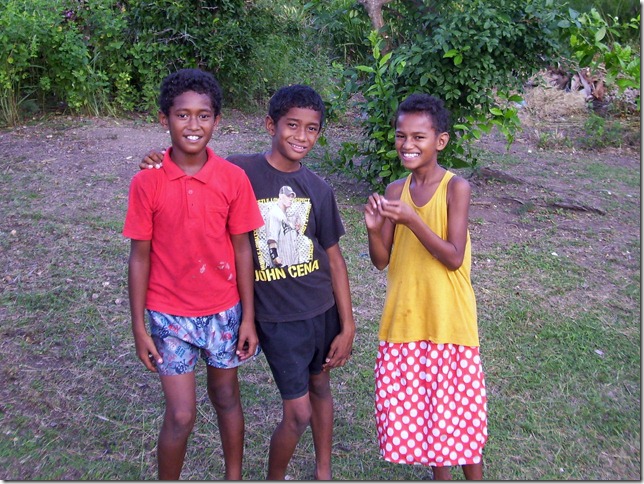 Our guides for the hike up the hilltop
Our guides for the hike up the hilltop
The walk back got us to the beach at sunset, but the tide had already been coming in for a couple of ours. We’d brought swim suits and scuba booties in anticipation and ended up needing them. We walked out a fair distance in knee to waist deep water over to the edge of the tidal flats where Ash and James (who’d swum out to the dinghy) met us and gave us a ride back to the boat.
The engine had died on Ash as he was motoring over to pick us up. I’d spent quite a bit of time trying to recover it, and had gotten a couple hours of good help from S/V Brickhouse in Suva, but it still wasn’t really reliable. It would run well for a while and then refuse to start, and often needed to be run at high RPMs. Yet another carb disassembly and pilot jet cleaning seemed to finally do the trick though, and we were finally able to set the idle nice and low and get it to start reliably. At this point, it’s really hard to imagine a few days going by without working on the outboard, but it seems to be good for now.
Aside from the dirty water and long paddle to the Yacht Club, Suva was really not bad for a city of 200,000 or so. There aren’t many tall buildings and the downtown area, which has most everything you need can be walked easily. Taxis are plentiful and cheap, as is good Indian and Fijian food. Nearly half of the population of Fijian is Indian. The Indians were originally brought by the British as indentured servants to work the sugarcane plantations and are now a large percentage of the population in the urban areas and very active in commerce. The city center is a colorful, busy place.
Even for a big city, the Fijian people have been incredibly friendly. While Shiroma and I were making the rounds downtown to get her released as crew from Pura Vida, we stopped to have lunch in the large and bustling market. We bought a couple of samosas and sat at a picnic table beside in between two of the small stalls. Unlike the US, where it’s very rare to share a table with someone you don’t know, we were almost immediately joined by two Fijian men. One was an older man who was eating a homemade local dish that was the fruit of some sort of tree that was then ground and apparently mixed with water to make is a sort of very moist and dense semi-sweet cake-like substance that was wrapped in leaves. He saw us looking at it and broke off large pieces for us supplement our lunch. The second man was younger and broke off a piece of his lunch, which was like a hard semi-sweet cake covered with a firm custard and also gave us some to eat. He spoke even less English that the older man, but both were so obviously friendly with complete strangers that it was hard to feel like we were in the middle of the largest city in Fiji. The price of food also adds to the appeal — I had breakfast for $0.45 US, pre-packaged lunches in the market are $1 US, and a big lunch that often feeds two with a drink at an Indian restaurant was just over $5 US.
But, after a week we were ready to get out to the islands, so with our new crew of 6 we stowed the dinghy, extracted the anchor from the disgusting black gunk at the bottom of Suva harbor, and motored out past the hurricane shipwrecks and confiscated Asian fishing vessels that litter Suva harbor. During our stay, it had rained every day except our arrival day and the wiring between the GPS and chartplotter had gotten wet enough that the GPS wasn’t talking to the chartplotter (another to-do list item), leaving us to make our exit through the reef using visual piloting, which went well and we were soon on our way to Yanuca.
Yanuca and Beqa are the small and large inhabited islands of a giant lagoon formed by the caldera of an ancient volcano. They’re also home to Fiji’s firewalkers and some of the best soft coral dives in the world. The northwest portion of the lagoon provides nutrients from the ocean currents while at the same time limiting the wave damage so that the coral can thrive. As we sailed around the south tip of Yanuca, we spotted what seemed to be a giant piece or wood or bunch of floating seaweed off to port. A closer look through the binoculars confirmed that it was a giant brown turtle maybe 6 feet across with a massive head that popped up occasionally. Both the color and size are unique and it turns out that we saw a leatherback turtle, one of the three species present in Fiji and on the world’s endangered species list.
We dropped anchor on the west side of Yanuca in 25 feet of crystal clear water. It’s been warm and humid, and almost everyone was in the water for a swim while the dinghy was prepared for going ashore. The first beach we tried was home to a surf resort run by an America woman who hasn’t been off the tiny island in more than a year. Surf resorts are pretty common in this part of Fiji. In some cases a particularly good and famous break will be owned by the adjacent resort and only surfers staying at the pricey resort are allowed to surf it. In the case of Yanuca, the break was on a reef near a pass well offshore, so a boat from the island would take the surfers out for the morning or afternoon and then pick them up later.
Our mission ashore was to present sevusevu ashore was to present sevusevu to the chief, so we headed back to the dinghy and paddled over to the next beach where a woman was sitting on the ground with four children playing nearby. We explained our mission and she instructed one of the small boys to show us the path across the island to the village. As large fruit bats flew overhead, we tramped through the bush across the small island until we reached the village on the other side. Each time you go to a new Fijian island or island group in the more remote places, you’re required to go present sevusevu to the chief. Sevusevu is comprised of a gift of dried kava root (about half a kilo for $15 Fijian from the market) and a ceremony. Basically, someone from the village meets you and takes you to the chief’s home where the ceremony is performed. In our case, we were befriended by one of the teachers at the local school who took us on a slow walk through the village to the chief’s house. All walks through the village are slow in Fiji. They start by removing any hats and carrying any bags or backpacks in your hand instead of over your shoulder. As you walk through the village, there are many exchanges of "Bula!" (hello/health) with playing children, people barely visible inside of their houses, and passers by on the path through the village.
Once we arrived at the chief’s house, he welcomed us in and invited us to sit in the traditional circle on woven pandanus mats. I sat to the left of the chief and the teacher sat to my left. At that point, the ceremony started and I did as I’d read and handed the bundle of kava to the teacher. He then said a piece in the local language that introduced us to the chief and then placed the gift of kava in front of the chief. The chief picked it up, sat it down, then picked it up with his right hand and tapped it into his open right hand, all the while sort of bending over and partially straightening and saying what seemed like a familiar and almost formal pronouncement that included the word sevusevu a couple of times. He then put the kava back on the mat and that was the end of it. We were now free to make ourselves guests of the island and the water that surrounded it.
The teacher asked if we’d like to have a kava ceremony as well, and as most of us had never tried it, we were certainly interested. The dried kava is pounded manually into a powder and the teacher pulled a bag of the powder out as well as a slightly porous bag, a large bowl, and a couple of small bowls. The powder went into the porous bag, water was poured into the large bowl, and then in went the bag, where it was washed around sort of like it was being washed, and turned the water brown. He tasted it once or twice, declared it to be excellent, but too strong, added more water, and mixed some more. Finally, he was happy with the potency and we got down to business. First, there were the clapping instructions. The recipient of the small bowl must clap once before receiving it. While he is drinking, everyone else in the circle claps three times in unison. When he’s done drinking, he must clap three times and then the others clap a bit. Next, he needed to inquire about drink sizes — the options were low tide, high tide, and tsunami. He asked with a bit of good natured bravado, so I figured I’d better man up and go for the tsunami. He did a little talking, clapping, and arm waving over the kava bowl then filled one of the small bowls and handed it to me to be the first to drink. When I saw the bowl full of muddy-looking water I had second thoughts about my order, but I did my pre-drink clap and then proceeded to drink it all down at one go as the rules of kava drinking dictate. The taste actually wasn’t too bad, but you wouldn’t confuse it with Kool-Aid. The effects are primarily a numbing of the tongue, though if you drink enough it’s supposed to be fairly stupefying. I returned the bowl, did three hearty claps, and then the process was repeated around the circle.
We took a break in between each of the three rounds that were required to drain the large bowl and chatted. This mostly consisted of us asking questions about what we were permitted to do and about the history and nature of the village and them answering our questions and telling us about the area. There are about 200 people in the village, and their generator broke about a year and a half ago. Some of the people have small personal generators as does the chief. He turns his on at night and invites villagers over to watch DVDs. Even though electricity is in short supply, there’s a cell phone tower at the center of the island and cell phones are common. The government system in the village is fairly simple. The chief is chief by birthright, but the headman is elected by the village. The headman seems to be more relevant in matters related to the national government, but the chief is the soft spoken head authority of the village. They told us firewalking was a gift by the gods long ago and offered a show for us — $50 US each to watch, free to give it a shot yourself. We decided to pass, but it was interesting to listen to. The houses are simple affairs. Some are cinder block and others are corrugated tin over a wood frame. Windows are plentiful and are either open or have venetian-blind style glass or plastic. Doors are either absent or open. In general, the only shoes are worn on the rugby field, which is a mainstay of each village and seems to be full of the local men and boys every evening.
After another slow walk through the village with plenty of Bulas and visiting, we eventually made our way back across the island and paddled back to the boat to enjoy dinner with clear water below and a clear sky with a full moon above. It finally felt like we were back in the islands.
Colin’s blog about his adventures aboard Pura Vida and his amazing pictures can be found at http://deadreckoningreports.com. Check it out.
It’s been a while since we’ve blogged, but not for lack of adventure. We’ve been pretty busy ever since Colin arrived and we left the mainland. I met him at the airport right around midnight on Wednesday. After several last-minute trips to Fijian immigration to get his entry permit letter signed by the Fijian Director of Immigration (one-way tickets into Fiji require formal permission), I was a little worried about immigration hassles, but nobody even asked to see the letter and we were off in a cab toward Nadi within minutes. Colin’s blog on the trip is well worth a read, but suffice it to say that since no late-night busses or mini-busses were running that night, we had an informal late night cab ride ($75 US for the 3 hours trip) that included a stop to pick up a few beers from a severely kava-intoxicated shopkeeper, a stop to pick up the cab driver’s sleeping friend to help keep him awake during the drive, a stop to avoid several very large and unimpressed cows who had taken possession of Fiji’s main highway (two-lanes through villages with one phone booth near the road in each village), and a couple more stops to discharge said beers.
We spent the hours of the ride catching up and swapping stories and finally arrived at the Royal Suva Yacht Club an hour or so before daylight. Once aboard, I settled in for a couple hours sleep before our dawn departure. Colin was still too excited to sleep and woke me up at dawn to get moving.


